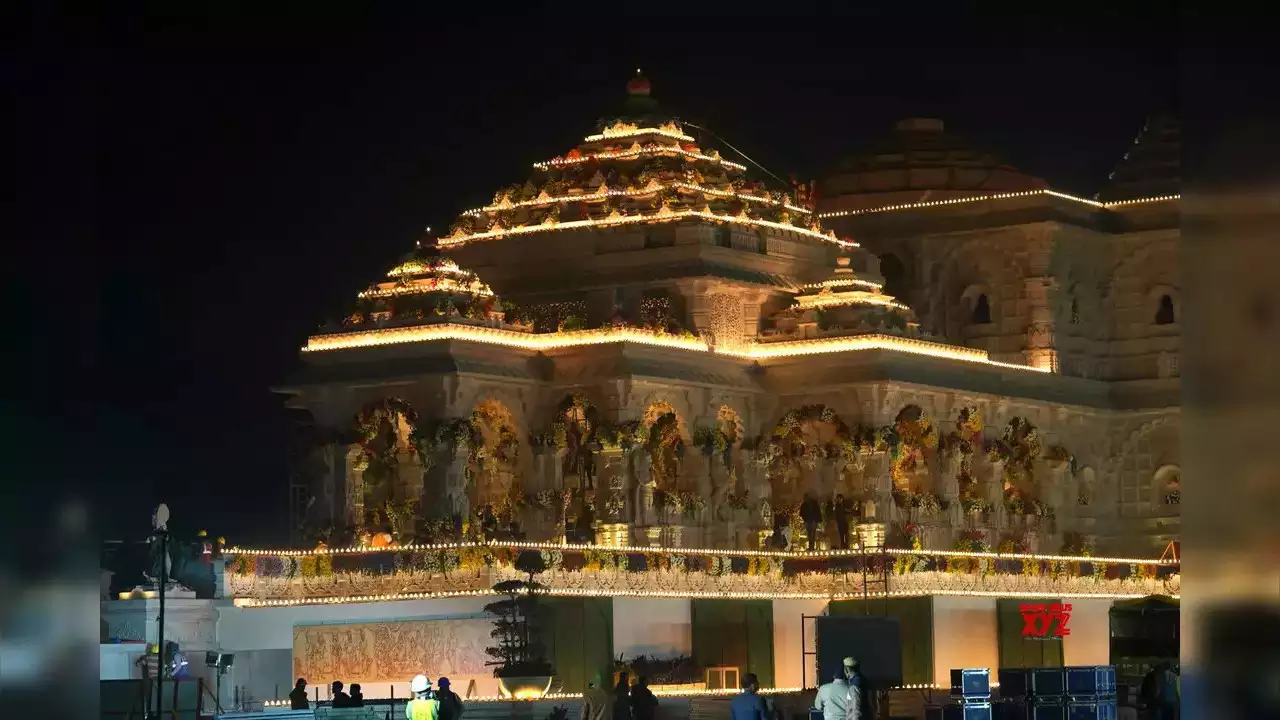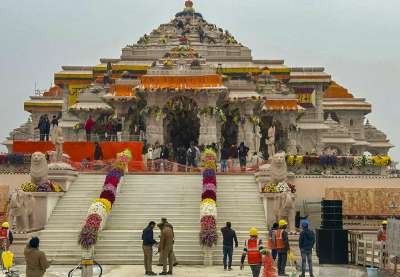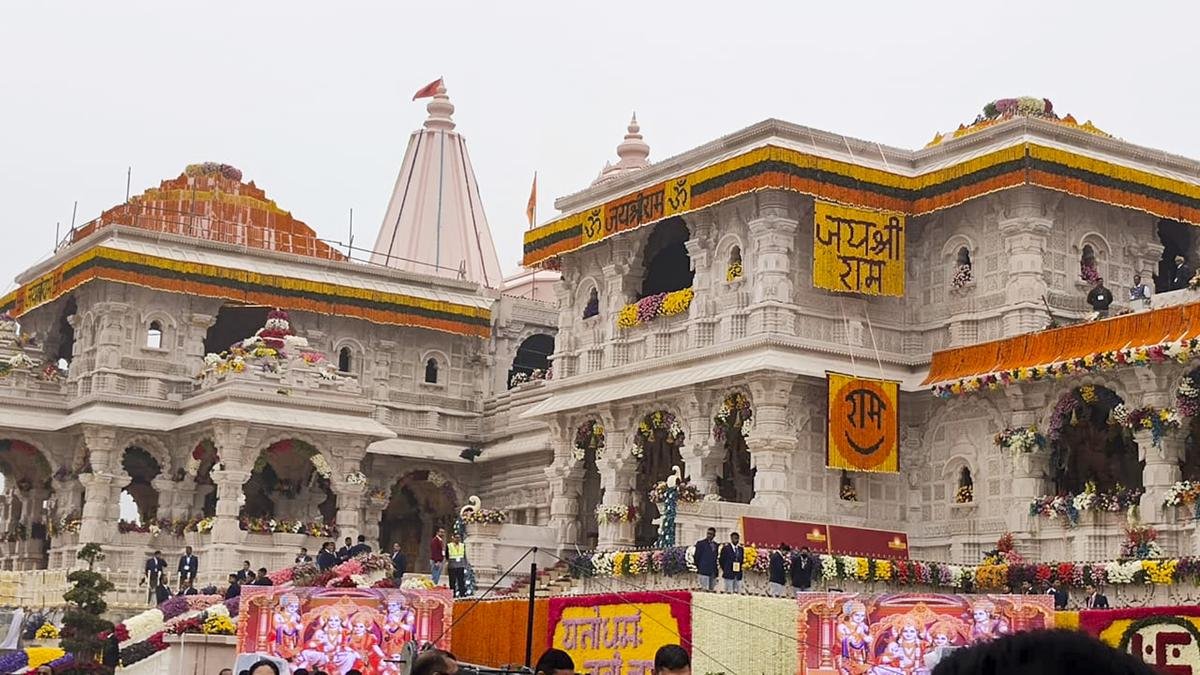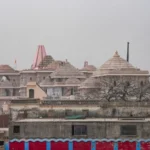The sacred town of Ayodhya is immersed in an overwhelming atmosphere of religious fervor as it prepares for the historic consecration of the Ram Temple LIVE. The highly anticipated event, featuring the ‘Pran Pratishtha’ ceremony, is set to commence at 12:20 p.m., with Prime Minister Narendra Modi among the dignitaries attending the rituals. This momentous occasion marks a significant chapter in India’s cultural and religious history, drawing not only national attention but also capturing the interest of a global audience.
The ‘Pran Pratishtha’ ceremony, scheduled to conclude by 1 p.m., will be followed by an address from Prime Minister Modi to a gathering of more than 7,000 individuals, including seers, prominent personalities, and distinguished guests. The select list of 506 A-listers comprises leading politicians, industrialists, film stars, sports icons, diplomats, judges, and high priests. The symbolism of this event is so profound that the Centre has granted a half-day off to all government employees, including those in public sector banks, and several states have declared a public holiday to allow citizens to partake in this historic moment.
The consecration ceremony is the culmination of the first phase of the temple’s construction, made possible by a landmark Supreme Court judgment in 2019 on the Ram Janmabhoomi-Babri Masjid title suit. The legal battle revolved around the claim that the Babri Mosque was constructed on the site of a temple marking the birthplace of Lord Ram. In 1992, the 16th-century mosque was tragically demolished by ‘kar sevaks,’ leading to heightened communal tensions.

Standing proudly on 2.7 acres of land in Ayodhya, the Ram Temple is a marvel of architectural brilliance. Soaring to a height of 161 feet, with a width of 235 feet and a total length of 360 feet, the temple follows the distinguished Nagara style, one of the two ancient temple-building styles in India. This architectural masterpiece seamlessly blends Vedic rituals with modern technology, covering a built-up area of nearly 57,000 square feet across its three floors, standing at approximately 70% of the iconic Qutub Minar’s height.
As Ayodhya gears up for this historic occasion, security measures have been significantly intensified. The Uttar Pradesh government has employed advanced technologies, including surveillance drones, night vision devices, and CCTV cameras. The Integrated Traffic Management System (ITMS), integrated with 1500 public CCTV cameras, ensures vigilant monitoring throughout the city. Teams from the National Disaster Response Force (NDRF) and the State Disaster Response Force (SDRF) have been deployed, and Ayodhya Railway Station will witness heightened security. An anti-drone system overseen by the Special Security Force (SSF) adds an extra layer of protection against potential aerial threats. Entry to the event is restricted to those invited by the Shri Ram Janmabhoomi Teerth Kshetra Trust, with stringent security and transportation arrangements in place.
Prominent figures, including Bollywood superstar Amitabh Bachchan, business magnates Mukesh Ambani and Gautam Adani, and sports icon Sachin Tendulkar, will grace the event as state guests, adding to the grandeur of the ceremony.

The ‘Pran Pratishtha’ Ceremony Timeline:
The day begins with a morning puja, leading to the ‘Pran Pratishtha’ of Ram Lalla in the auspicious. ‘Mrigashira Nakshatra.’ The ceremony, commencing at 12:20 pm, is expect to conclude by 1 pm. Prime Minister Narendra Modi. Along with Rashtriya Swayamsevak Sangh chief Mohan Bhagwat, Uttar Pradesh governor Anandiben Patel, and Chief Minister Yogi Adityanath. Will be present among other dignitaries. The ceremony will be followed by Prime Minister Modi’s address to the gathering. Paving the way for the public opening of the Ram Temple a day later.
A Glimpse into the Future: A New Mosque in Ayodhya
As the Hindu community rejoices in the inauguration of the Ram Temple. India’s minority Muslim population is planning to begin the construction of a new mosque in Ayodhya later this year. The Indo-Islamic Cultural Foundation (IICF), overseeing the mosque project. Has announced that construction is set to commence in May, after the holy month of Ramadan. With an estimated completion time of three to four years.
The backdrop of this development is rooted in the tragic demolition of a 16th-century mosque in Ayodhya. By Hindu zealots in 1992. The subsequent legal battles culminated in a Supreme Court ruling in 2019, acknowledging. The unlawfulness of the mosque’s destruction but also recognizing evidence of a non-Islamic structure beneath it. The court ordered the site to be given to Hindu groups for the construction of a temple. And allocated alternative land in the city to Muslim community leaders for the mosque.
While the construction of the $180 million Ram Temple began promptly and is set to open in the first phase on Monday, Muslim groups have face challeng in raising fund and initiating work at a site locat approximately 25 km away. The mosque project has been delayed partly due to the need for redesigning to incorporate more traditional elements such as minarets. The IICF has also planned a 500-bed hospital within the mosque complex. To overcome funding challenges, a crowd-funding website is expected to be launched in the coming weeks, as confirmed by Haji Arfat Shaikh, head of the IICF development committee and a BJP leader.
The mosque, named “Masjid Muhammed bin Abdullah” after Prophet Mohammad, aims to move away from the contentious. Title of “Babri Masjid.” The IICF’s President, Zufar Ahmad Faruqi, emphasized the effort to transform enmity and hatred into love among people. Irrespective of differing views on the Supreme Court judgment. Faruqi stated. “All this fighting will stop if we teach good things to our children and people.”
Also Read :22 January 2024 Ram Mandir Inauguration: A Momentous Day of Celebrations and Holidays
Global Sensitivity: Pakistan Hindus and Communal Harmony
While Hindus in neighboring Pakistan express joy at the ‘Pran Pratishtha’ of Ram Lalla in Ayodhya. They maintain a delicate balance during the festivities to respect the religious sensitivities of their Muslim neighbors. Krishan Sharma, president of the Pakistan Hindu Mandir Management Committee (PHMMC), acknowledges. The restraint exhibited by Muslim friends, business partners, and neighbors. After the Babri Masjid demolition. He emphasizes the need for reciprocation, stating. “Now, it is upon us to showcase a harmonious and considerate approach to communal interactions.” Amarnath Randhawa of the PHMMC adds that Muslims in Hindu-populated areas in Pakistan avoid sacrificing bovine animals. Considering the sentiments of their Hindu neighbors.
In conclusion, the ‘Ram Temple LIVE’ event in Ayodhya is not merely a religious ceremony. But a symbol of cultural harmony and the quest for peaceful coexistence. As the consecration of the Ram Temple unfolds, it is a testament to India’s rich tapestry of diversity. Where multiple faiths and communities navigate shared history, acknowledging differences, and striving for unity. The inauguration of the temple and the upcoming mosque project represent steps toward. Reconciliation and understanding, fostering a spirit of mutual respect and acceptance.







